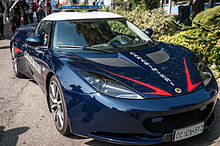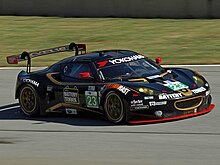Lotus Evora
| Lotus Evora | |
|---|---|
 | |
| Overview | |
| Manufacturer | Lotus Cars |
| Production | 2009–present |
| Model years | 2010–present |
| Assembly | Hethel, Norfolk, England |
| Designer | Russell Carr[1] |
| Body and chassis | |
| Class | Sports car (S) |
| Body style | 2- or 2+2-passenger coupé |
| Layout | Transverse mid-engine, rear-wheel drive |
| Powertrain | |
| Engine | 3.5 L Toyota 2GR-FE V6 (280 PS (206 kW; 276 hp))[1][2] 3.5 L Toyota 2GR-FZE V6 (supercharged, 350 PS (257 kW; 345 hp)) |
| Transmission | 6-speed manual[1] built by Aisin AI 6-speed automatic |
| Dimensions | |
| Wheelbase | 2,575 mm (101.4 in)[1] |
| Length | 4,350 mm (171 in) |
| Width | 1,848 mm (72.8 in) |
| Height | 1,229 mm (48.4 in) |
| Kerb weight | 1,383 kg (3,049 lb) 1,442 kg (3,179 lb) (S IPS model)[3] |
The Lotus Evora[4] is a sports car produced by British car manufacturer Lotus.[1] The car, which was developed under the project name Project Eagle, was launched as the Evora on 22 July 2008 at the British International Motor Show.[5] The Evora S was launched in 2010 with a supercharged equipped 3.5-litre V6. A facelifted and more powerful Evora 400 model was unveiled at the 2015 Geneva Motor Show.[6]
Development
The Lotus Evora is based on the first all-new vehicle platform from Lotus Cars since the introduction of the Lotus Elise in 1995 (the Exige, introduced in 2000, and the 2006 Europa S are both derivatives of the Elise[7]).[8] Evora was planned to be the first vehicle of three to be built on the same platform.[9]

Evora is the first product of a five-year plan started in 2006 to expand the Lotus line-up[2] beyond its current track-specialized offerings, with the aim of making Evora a somewhat of a more practical road car that would appeal to the mainstream.[10] As such it is a larger car than recent Lotus models Elise and its derivatives (Exige, Europa S, etc.), with an unladen weight of 1,383 kg (3,049 lb).
It is currently the only Lotus model with a 2+2 configuration, although it has been announced that it will also be offered in a two-seater configuration, referred to as the "Plus Zero" option.[1] It is also the only 2+2 mid engined coupé on sale. The interior is larger to allow taller persons to fit, such as Lotus CEO Mike Kimberley,[1] and two 6'5" (195.6 cm) tall people.[11]
The cooled[12] boot behind the engine is large enough to fit a set of golf clubs, although Lotus Design Head Russell Carr denies that this was intentional.[1] Lotus intends Evora to compete with different market sectors including the Porsche Cayman.[2]
Name
The name "Evora" keeps the Lotus tradition of beginning model names with an "E". The name is derived from the words evolution, vogue, and aura.[13] Other names considered were Eagle, Exira and Ethos; Exira was rejected as it was considered not good enough and the other two because it would be difficult for Lotus to claim them as a trademark.[2] The name "Evora" sounds similar to Évora, which is the name of a Portuguese city and UNESCO World Heritage Site, in Portugal.
Production
Sales were expected to start in summer 2009,[14] The sales target is 2000 cars per year, with prices between £45,000 and just over £50,000.[1] and in America from the beginning of 2010.[15]
Reception
The Evora received several accolades at its launch from the British motoring press, including: Britain's Best Driver's Car 2009 from Autocar[16] and Car of the Year 2009, from Evo[17]
The car was reviewed by Jeremy Clarkson on the television show Top Gear. Overall his review was positive: he was very happy with the performance, handling and comfort. He was extremely impressed with the ride comfort even after driving it into a field saying "Here, the suspension is taking the knocks, not me." and described the car as "the only car I've ever driven, ever, which is a killer attack dog and an old sofa". However, he considered the rear seats to have not enough legroom, the interior felt tinny and the satellite navigation was sub-optimal.[18]
Performance
The Evora is equipped with a mid-mounted, transverse, Toyota-sourced 3.5-litre 24-valve V6 engine. The Evora S uses the same engine but with a supercharger. Both versions are available with a 6-speed manual or 6-speed automatic with "Intelligent Precision Shift" by Aisin.[19] The Evora has a drag coefficient of Cd=0.337.[1]
| Model | Power | Torque | Emissions CO2 |
Top speed | Acceleration 0-60 |
Economy (combined) |
|---|---|---|---|---|---|---|
| Evora | 276 bhp (206 kW; 280 PS) @ 6,400 rpm | 258 lb⋅ft (350 N⋅m) @ 4,600 rpm | 217 g/km | 163 mph (262 km/h) | 4.8 secs | 30.3 mpg‑imp (9.3 L/100 km; 25.2 mpg‑US) |
| Evora IPS | 276 bhp (206 kW; 280 PS) @ 6,400 rpm | 258 lb⋅ft (350 N⋅m) @ 4,600 rpm | 210 g/km | 159 mph (256 km/h) | 5.0 secs | 31.4 mpg‑imp (9.0 L/100 km; 26.1 mpg‑US) |
| Evora S | 345 bhp (257 kW; 350 PS) @ 7,000 rpm | 295 lb⋅ft (400 N⋅m) @ 4,500 rpm | 229 g/km | 178 mph (286 km/h) | 4.4 secs | 28.7 mpg‑imp (9.8 L/100 km; 23.9 mpg‑US) |
| Evora S IPS | 345 bhp (257 kW; 350 PS) @ 7,000 rpm | 295 lb⋅ft (400 N⋅m) @ 4,500 rpm | 224 g/km | 167 mph (269 km/h) | 4.5 secs | 29.3 mpg‑imp (9.6 L/100 km; 24.4 mpg‑US) |
| Evora 400 | 400 bhp (298 kW; 406 PS) @ 7,000 rpm | 302.5 lb⋅ft (410 N⋅m) @ 3,500 rpm | 225 g/km | 186 mph (299 km/h) | 4.1 secs | 29.1 mpg‑imp (9.7 L/100 km; 24.2 mpg‑US) |
| Evora 400 Auto | 400 bhp (298 kW; 406 PS) @ 7,000 rpm | 302.5 lb⋅ft (410 N⋅m) @ 3,500 rpm | 225 g/km | 174 mph (280 km/h) | 4.1 secs | 29.1 mpg‑imp (9.7 L/100 km; 24.2 mpg‑US) |
Chassis
The Evora is constructed from a modular lightweight bonded aluminium structure with composite body panels. It features forged aluminium double wishbone suspension with Bilstein high-performance gas dampers and Eibach coaxial coil springs. Steering is by hydraulically assisted power steering.
Evora GTE Road Car
The Evora GTE is a race car developed for the new global motorsport GTE category, which includes the Le Mans 24 Hours. To coincide with this new model, Lotus has built a limited number of GTE road cars representing the most powerful Lotus road cars ever built.[20] Producing over 444 PS from the race developed Lotus Evora GTE engine, fed through a sequential AMT racing gearbox. Transferring this power to the road, are lightweight, forged alloy rims with centre lock hubs shod with Pirelli P-Zero Corsa tyres.
Evora S and the Carabinieri

In July 2011, Lotus Cars donated two Evora S models with special equipment to the Carabinieri, the Italian gendarmerie. Lotus will take care of the maintenance of the cars and the training for the drivers.
Evora 414E Hybrid
In 2012, Lotus produced a prototype hybrid Evora, called 414E. Developed as a demonstration project for the UK Government's Technology Strategy Board, the range-extended electric coupe emits 55g/km CO2 and has an electric only driving range of 30 miles.[21] When combined with the 3-cylinder 1.2-litre (1198 cc) petrol engine acting as a generator (as a similar manner to the Chevrolet Volt), the 414E has a range of 300 miles. The 414E formed the basis of the Infiniti Emerg-e concept car.[22]
Motorsport

Ollie Hancock won the Nurburgring round of the 2010 GT4 European Cup season. A team including Johnny Mowlem, Stefano D'Aste and Gianni Giudici finished on the podium in the 2011 Dubai 24 Hour endurance race.[23]
In 2011 Stefano d'Aste was the first Italian driver after Mario Andretti to win on Zandvort track with an Official Lotus car and the car was the Evora GT4. D'Aste was in first position of the European GT4 serie till the last race but due to a problem occurred to the engine he got a great third place in the serie. The result was great considering that it was the first year that the Official Lotus Evora GT4 took part to a full season competing with cars and brands like Bmw M3, Porsche 911, Aston Martin GT4 Vantage, Camaro; cars that are the evolution of the evolution. The car proved to be very competitive.
During the 2011 Geneva motor show, Lotus announced the Evora enduro GT concept, as a follow up to the Type 124 and GT4 race cars. Lotus is aiming for this car to enter into the GT3 category by Mid-2011, with a 444 bhp Toyota supplied V8.
Lotus entered two Evoras at the 2011 24 Hours of Le Mans, which were run by the Jetalliance Racing team. Despite overheating issues during practice and qualifying, car no.65 finished 22nd overall, completing 295 laps, whilst car no.64 retired after 126 laps.
In 2012, Jetalliance Racing failed to negotiate a deal to run the cars in Europe; instead, Alex Job Racing chose to run a GTE in the American Le Mans Series.
References
- ^ a b c d e f g h i j "Lotus Evora". EVO. Dennis Publishing. 22 July 2008. Retrieved 22 July 2008.
- ^ a b c d "London show: Lotus Evora". Autocar. Haymarket Media. 22 July 2008. Retrieved 22 July 2008.
- ^ "Evora" (PDF). Lotus. Retrieved 22 July 2008.
- ^ "Evora a civilised Lotus". CarsGuide. Retrieved 27 November 2015.
- ^ "2009 Lotus Evora revealed: Project Eagle arrives". Leftlane News. 22 July 2008. Retrieved 22 July 2008.
- ^ "Evora 400 is the fastest Lotus ever". Top Gear. 18 February 2015. Retrieved 18 February 2015.
- ^ Holmes, Jake (March 2008). "2008 Lotus Europa SE – Auto Shows". Car & Driver. Hachette Filipacchi Media U.S. Retrieved 26 August 2009.
- ^ Mitani, Sam (August 2009). "Driving Impression: 2010 Lotus Evora". Road & Track. 60 (12). Newport Beach, California: Hachette Filipacchi Media U.S.: 52–55. Retrieved 26 August 2009.
- ^ "London show: Lotus Evora". Autocar. Haymarket Group. 22 July 2008. Retrieved 26 August 2009.
- ^ "2010 Lotus Evora – Test drive and new car review – 2010 Lotus Evora". Cars.about.com. 16 June 2011. Retrieved 28 January 2012.
- ^ "Lotus Evora in Details at BIMS". AutoSpies.com. 23 July 2008. Retrieved 24 July 2008.
- ^ "Lotus Evora press releases quoted by jalopnik". Retrieved 24 July 2008.
- ^ Mitani, Sam (August 2009). "2010 Lotus Evora". Road & Track. 60 (12). Hachette Filipacchi Médias: 52–55. Retrieved 9 August 2009.
- ^ "Official Lotus Evora website". Lotusevora.com. Retrieved 10 October 2010.
- ^ Davis, Matt (13 May 2009). "The Baby Ferrari That Ferrari Refuses To Build". Edmunds.com. Retrieved 26 June 2009.
- ^ "Evora is UK's Best Driver's Car". Autocar.co.uk. 14 August 2009. Retrieved 10 October 2010.
- ^ Barker, John (22 November 2010). "Lotus Evora Supercharged review". Evo. Retrieved 22 January 2015.
- ^ Presenters: CLARKSON, J., HAMMOND, R., MAY, J. (21 June 2009). "Lotus Evora road test". Top Gear. Episode 1. BBC. BBC. Retrieved 18 January 2011.
{{cite episode}}: Cite has empty unknown parameters:|began=,|episodelink=,|city=, and|ended=(help); External link in|transcripturl=|serieslink=ignored (|series-link=suggested) (help); Unknown parameter|seriesno=ignored (|series-number=suggested) (help); Unknown parameter|transcripturl=ignored (|transcript-url=suggested) (help) - ^ Adcock, Ian (October 2011). "Lotus Evora IPS". Road & Track. 63 (2): 39.
- ^ "New Lotus Evora GTE vs the Stig". Top Gear. 12 July 2012. Retrieved 22 January 2015.
- ^ Clarke, Paul (22 October 2012). "Lotus Evora 414E: behind the wheel of an electric sports car". The Guardian. Retrieved 22 January 2015.
- ^ Holloway, Hilton (1 October 2012). "First drive review: Lotus Evora 414E Hybrid". Autocar. Retrieved 22 January 2015.
- ^ "Lotus Evora GT4 Endurance gets on the podium in Dubai". Paul Tan's Automotive News.

